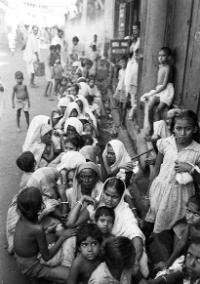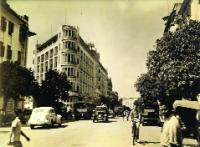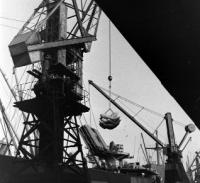Demographic crisis: Revisiting the Bengal famine of 1943–4
Published in 20th Century Social Perspectives, 20th-century / Contemporary History, Features, Issue 4 (July/August 2010), Volume 18
Refugee women and children queueing for food in Calcutta in December 1943. Having to queue for hours for food forced such migrants to indulge in unhygienic practices and created unhealthy conditions in the localities where shops were located. (William Vandivert, Life)
The Great Bengal Famine of 1943–4 resulted in the deaths from starvation and famine-related diseases of over two million people. In pre-partition Bengal it reawakened dim collective memories of Chhiatt?rer monn?ntór, the massive but poorly documented famine that had produced devastation in 1770. In India and Bangladesh both famines are seen as colonial famines: the earlier as the product of the East India Company’s rapacity, the later the result of a lack of concern on the part of an imperial power focused on waging World War II. The 1943–4 famine is noteworthy for being India’s—though not Bangladesh’s—last major famine.

The Hindustan building in the centre of Calcutta. In many respects life proceeded as normal, since the authorities prioritised the city and its war-related production over the rest of the province (note the military vehicles). Concern for Calcutta’s ‘priority classes’ accounted for the forcible requisition of rice from mills and warehouses in and around the city in late December 1942.
The secretary for state for India, Leo Amery, now began to listen and to argue the case at the war cabinet. The head of British forces in India, echoing Amery’s request, pleaded with London that ‘so far as shipping is concerned, the import of food is to my mind just as if not more important than the import of munitions’. But to no avail. Another rebuff by the war cabinet prompted Amery to muse in his diary that ‘Winston [Churchill] may be right in saying that the starvation of anyhow under-fed Bengalis is less serious than sturdy Greeks, at any rate from the war point of view, but he makes no sufficient allowance for the sense of Empire responsibility in this country’. Although in mid-October Amery was still referring in public only to ‘scarcity verging on famine’, in private he knew that the game was up. Churchill’s lack of empathy for India did not help; his immediate reaction to Amery’s last-ditch plea for more shipping was ‘a preliminary flourish on Indians breeding like rabbits and being paid a million a day by us for doing nothing about the war’.

Food being unloaded at Calcutta port. In late July 1943 the viceroy, Lord Linlithgow, demanded food imports as a matter of extreme urgency, no matter ‘how unpalatable this demand must be to HMG’. Yet by mid-October the secretary for state for India, Leo Amery, was still referring in public only to ‘scarcity verging on famine’. Churchill was even less sympathetic, referring to ‘Indians breeding like rabbits and being paid a million a day by us for doing nothing about the war’.
(William Vandivert, Life)
The ‘food drives’ of summer 1943 followed from the hoarding hypothesis, and the meagre hoards located by them are strong evidence against the claim that there was enough food for all. The first drive, which excluded the twin cities of Calcutta and Howrah, began on 7 June. It unearthed little rice, and food minister Suhrawardy’s claim that boats and carts had been used to conceal stocks impressed nobody. The drive laid bare the gravity of the situation. The second drive, targeting Calcutta–Howrah in early August 1943, forced Suhrawardy to concede that stocks in the hands of consumers, traders and employers were meagre.
















